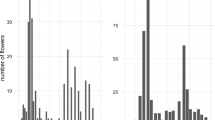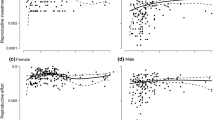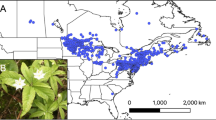Summary
We investigated the effects of plant density on cleistogamous (CL) and chasmogamous (CH) flowering phenology and seed production in a natural Impatiens capensis population, by censusing individually marked plants at experimentally reduced and natural densities. CL flowering was earlier at natural density. This plastic density response may have resulted from a stress-related threshold for CL flowering; slower growing plants at natural density flowered earlier. Although apparently triggered by slow early growth, early CL flowering also involved an additional cost for later growth rate. In contrast, CH flowering was unrelated to relative growth rate, but apparently required a size threshold. Experimental density reduction resulted in earlier CH flowering and a dramatic increase in the percentage of plants producing CH flowers. Individual CL and CH flowering duration and flower production were greater at reduced density. These density-dependent effects caused differences between treatments in the shape and location of population flowering phenology curves. Moreover, the percentage of CH seeds produced per individual was much higher at reduced density. At natural density total seed production per plant was lower and more hierarchical than at lower density, suggesting that dominance and suppression shape jewelweed fitness distributions.
Similar content being viewed by others
References
Antonovics J (1978) Evolution in closely adjacent plant populations. V. Evolution of self-fertility. Heredity 23:219–238
Antonovics J, Levin DA (1980) The ecological and genetic consequences of density-dependent regulation in plants. Ann Rev Ecol Syst 11:411–452
Clay K, Shaw R (1981) An experimental demonstration of density-dependent reproduction in a natural population of Diamorpha smallii, a rare annual. Oecologia (Berlin) 51:1–6
Ellison A (1986) The ecology of Salicornia europaea in a New England salt marsh. PhD dissertation, Brown University
Harper JL (1977) Population biology of plants. London Academic Press
Heinrich B (1976) Flowering phenologies: bog, woodland, and disturbed habitats. Ecology 57:890–899
Lacey EP (1986) The genetic and environmental control of reproductive timing in a short-lived monocarpic species Daucus carota (Umbelliferae). J Ecol 74:73–86
Levin DA (1970) Reinforcement of reproductive isolation: plants versus animals. Am Natur 104:571–581
Levin DA (1972) Plant density, cleistogamy, and self-fertilization in natural populations of Lithospermum caroliniense. Am J Bot 59:71–77
Levin DA, Kerster HW (1971) Neighborhood structure under diverse reproductive methods in plants. Am Natur 104:345–354
Mitchell-Olds T, Waller DM (1985) Relative performance of selfed and outcrossed progeny in Impatiens capensis. Evolution 39:533–543
Palmblad IG (1968) Competition studies on experimental populations of weeds with emphasis on the regulation of population size. Ecology 49:26–34
Poole RW, Ratheke BJ (1979) Regularity, randomness, and aggregation in flowering phenologies. Science 203:470–471
Rabinowitz D, Rapp JK, Sork VL, Rathcke BJ, Reese GA, Weaver JC (1981) Phenological properties of wind- and insect-pollinated prairie plants. Ecology 62:49–56
Rathke B, Lacey EP (1985) Phenological patterns of terrestrial plants. Ann Rev Ecol Syst 16:179–214
Schemske DW (1978) Evolution of reproductive characteristics in Impatiens (Balsaminaceae): The significance of cleistogamy and chasmogamy. Ecology 59:596–613
Schemske DW (1984) Population structure and local selection in Impatiens pallida (Balsaminaceae), a selfing annual. Evolution 38:817–832
Schmitt J (1983a) Density-dependent pollinator foraging, flowering phenology, and temporal pollen dispersal patterns in Linanthus bicolor. Evolution 37:1247–1257
Schmitt J (1983b) Individual flowering phenology, plant size, and reproductive success in Linanthus androsaceus, a California annual. Oecologia (Berlin) 59:135–140
Schmitt J, Ehrhardt D, Swartz D (1985) Differential dispersal of self-fertilized and outcrossed progeny in jewelweed (Impatiens capensis). Am Natur 126:570–575
Schmitt J, Eccleston J, Ehrhardt DW (1987) Dominance and suppression, size-dependent growth and self thinning in a natural Impatiens capensis population. J Ecol (in press)
Simpson RL, Leck MA, Parker VT (1985) The comparative ecology of Impatiens capensis Meerb. (Balsaminaceae) in central New Jersey. Bull Torr Bot Cl 112:295–311
Smith B (1983) Demography of Floerkia proserpinacoides, a forest floor annual. II. Density-dependent reproduction. J Ecol 71:405–412
Stiles EG (1977) Coadapted competitors: The flowering seasons of hummingbird-pollinated plants in a tropical forest. Science 198:1177–1178
Symonides E (1978) Effect of population density on the phenological development of individuals of annual plant species. Ekologia Polska 26:273–286
Thompson DA, Beattie AJ (1981) Density-mediated seed and stolon production in Viola (Violaceae). Am J Bot 68:383–388
Thomson JD (1980) Skewed flowering distributions and pollinator attraction. Ecology 61:572–579
Turner MD, Rabinowitz D (1983) Factors affecting frequency distributions of plant mass: The absence of dominance and suppression in competing monocultures of Festuca paradoxa. Ecology 64:469–475
Uphof JCT (1938) Cleistogamic flowers. Bot Rev 4:21–49
Waller DM (1979) The relative costs of self-and cross-fertilized seeds in Impatiens capensis (Balsaminaceae). Am J Bot 66:313–320
Waller DM (1980) Environmental determinants of outcrossing in Impatiens capensis (Balsaminaceae). Evolution 34:747–761
Waller DM (1984) Differences in fitness between seedlings derived from cleistogamous and chasmogamous flowers in Impatiens capensis. Evolution 38:427–440
Waser NM (1978) Competition for hummingbird pollination and sequential flowering in two Colorado wildflowers. Ecology 59:934–944
Watkinson AR, Harper JL (1978) The demography of a sand dune annual: Vulpia fasciculata. I. The natural regulation of populations. J Ecol 66:15–33
Weiner J (1985) Size hierarchies in experimental populations of annual plants. Ecology 66:743–752
Weiss PW (1980) Germination, reproduction and interference in the amphicarpic annual Emex spinosa (L.) Campd. Oecologia (Berlin) 45:244–251
Wilbur HM, Collins JP (1973) Ecological aspects of amphibian metamorphosis. Science 182:1305–1314
Wilken DH (1982) The balance between cleistogamy and chasmogany in Collomia grandiflora (Polemoniaceae). Am J Bot 69:1326–1333
Author information
Authors and Affiliations
Rights and permissions
About this article
Cite this article
Schmitt, J., Eccleston, J. & Ehrhardt, D.W. Density-dependent flowering phenology, outcrossing, and reproduction in Impatiens capensis . Oecologia 72, 341–347 (1987). https://doi.org/10.1007/BF00377561
Received:
Issue Date:
DOI: https://doi.org/10.1007/BF00377561




